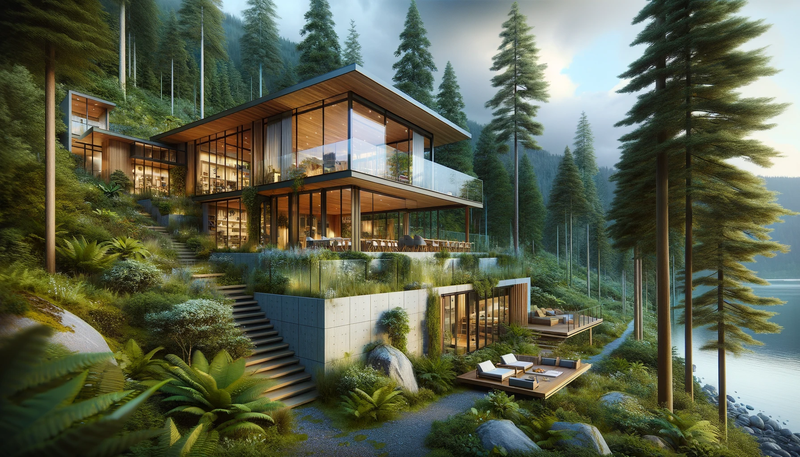Beyond Imagination: Unleashing Creativity with DALL-E in Conceptual Renderings
In the realm of digital creativity and design, the concept of rendering plays a pivotal role in transforming abstract ideas into tangible visual representations. A conceptual rendering, at its core, is the art of creating visual depictions to convey a concept, idea, or design that may not yet exist in the physical world. These renderings are instrumental in fields like architecture, product design, and visual arts, offering a glimpse into the potential future of a concept.
The use of conceptual renderings extends across various stages of creative and developmental processes. They are particularly prevalent in the initial phases of a project, where visualizing an idea is crucial for exploration, discussion, and refinement. These renderings are also key in presenting new concepts to stakeholders, clients, or the public, serving as a bridge between imagination and reality.
Enter DALL-E, an AI-driven tool developed by OpenAI, which revolutionizes the way we approach conceptual renderings. DALL-E harnesses the power of advanced artificial intelligence to generate images from textual descriptions, offering a new frontier for creating visual concepts. However, as with any technology, the use of DALL-E in rendering comes with its own set of pros and cons.
Pros of Using DALL-E for Conceptual Renderings
1. Speed : One of the most significant advantages of DALL-E is its ability to generate images rapidly. This speed transforms the process of conceptualization, allowing for quicker iterations and exploration of ideas. Designers and artists can experiment with various concepts without the time-consuming process traditional rendering methods require.
2. Cost-Effectiveness : Utilizing DALL-E is essentially cost-free, especially when compared to the high expenses often associated with sophisticated rendering software or the hiring of professional artists for conceptual illustrations. This accessibility democratizes the process of rendering, making it feasible for individuals and organizations of all sizes.
3. Innovative Visualizations : DALL-E excels in creating images that might be extremely challenging or even impossible to achieve using traditional rendering software. Its AI algorithms can interpret and visualize abstract, surreal, or highly creative concepts, pushing the boundaries of conventional design and art.
Cons of Using DALL-E for Conceptual Renderings
1. Inability to Use CAD Plans : A notable limitation of DALL-E is its inability to directly interpret and utilize CAD (Computer-Aided Design) plans. This restriction means that DALL-E is less suited for projects that require precise, technical accuracy, as often needed in architecture or engineering.
2. Limited Direction and Refinement : While DALL-E is remarkable in generating creative images, it struggles with following specific directions or making refined adjustments. The AI’s interpretation of textual prompts can sometimes be unpredictable, leading to results that may not align exactly with the intended concept.
3. Not Suitable for Client or Real-World Projects : Given its limitations in precision and predictability, DALL-E generated images are often not suitable for client presentations or real-world projects that require detailed and accurate representations. The tool is more aligned with the initial stages of concept development rather than the final, client-facing stages.
Using DALL-E for Sustainable Eco-Friendly Conceptual Images
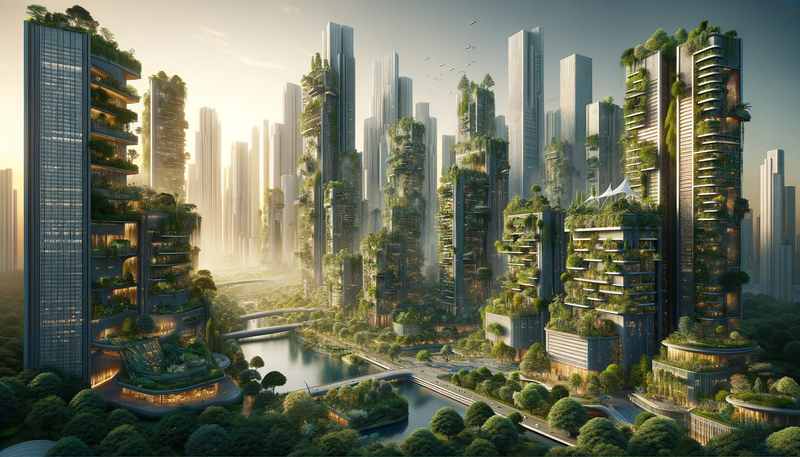
Biophilic Urbanism Images
DALL-E demonstrates exceptional proficiency in creating images that encapsulate the essence of biophilic urbanism – a design concept that integrates nature into urban settings. The AI's ability to blend architectural elements with natural landscapes results in stunning visualizations of cities where green spaces, water features, and living ecosystems coexist seamlessly with urban infrastructure. These renderings not only capture the harmony between built environments and nature but also help in envisioning sustainable and livable urban futures. DALL-E's adeptness in this area is a testament to its capacity for generating complex, multi-layered concepts that merge the organic with the constructed.
Good but Not Great at Homes Set in or Intersecting with Nature
When it comes to visualizing homes set in or intersecting with nature, DALL-E performs admirably, though it doesn't quite reach the same level of proficiency as it does with broader urban concepts. The AI can generate images that depict houses nestled in natural surroundings, highlighting the interplay between modern living and the environment. However, the detail and precision in these renderings may not always be on point. While DALL-E can capture the overarching theme of homes in harmony with nature, it sometimes struggles with the finer aspects of architectural design and the subtleties of natural landscapes. This slight mismatch may lead to renderings that, while visually appealing, lack the exacting details and nuanced integration that a professional human artist might achieve.
DALL-E for Underground Homes
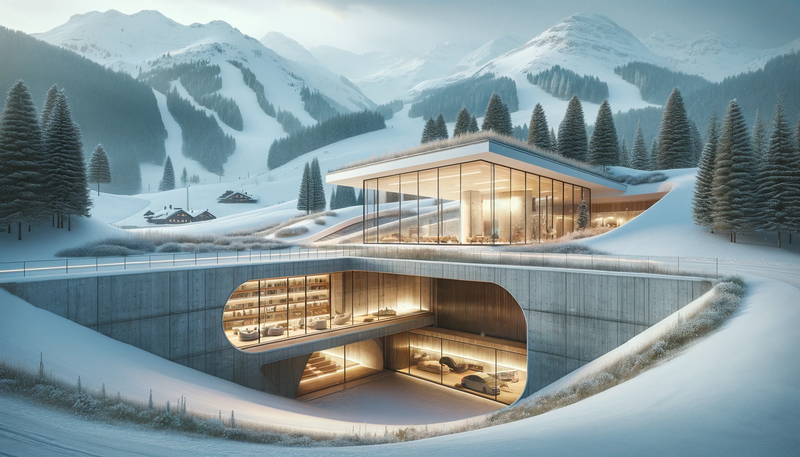
Exploring the niche of underground home design with DALL-E proved to be a challenging endeavour. Crafting images of subterranean dwellings required a considerable amount of specific instruction, highlighting one of DALL-E's limitations in grasping complex architectural concepts that deviate from conventional structures. The process to arrive at a realistic depiction of underground homes was iterative and demanded precise and often repetitive guidance to ensure the AI's understanding of the unique aspects of such designs.
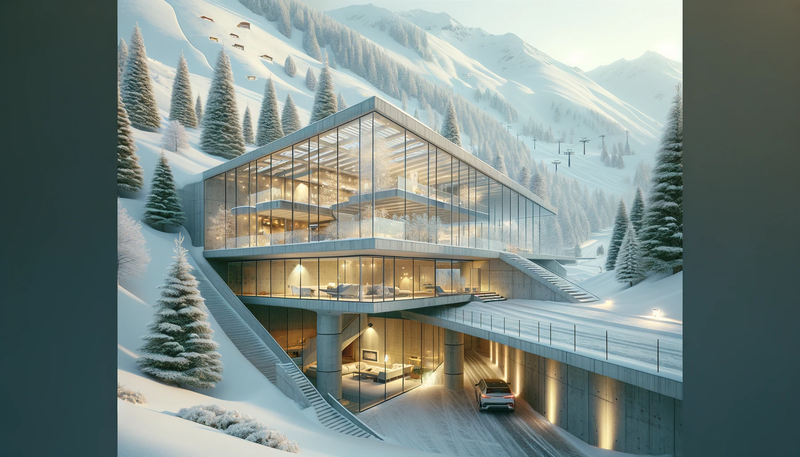
Despite these efforts, the resulting images, while intriguing, often fell short of appearing practical or livable. DALL-E's renderings tended to miss key elements that make underground living spaces functional and comfortable. The images sometimes lacked the integration of essential features like natural light sources, ventilation systems, and efficient spatial layouts. This limitation underscores DALL-E's current constraints in fully comprehending and visualizing architectural designs that require a deep understanding of both aesthetics and functionality, especially in unconventional settings like underground habitats. Consequently, while DALL-E can initiate a visual dialogue about alternative living spaces, its current capabilities might not yet fully align with the practicalities and nuances of designing habitable underground homes.
Floating Houses
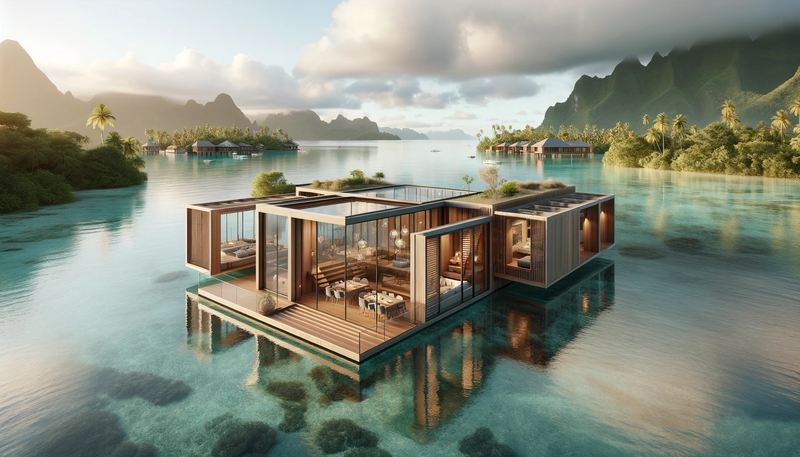
The endeavour to use DALL-E for rendering floating houses presented notable challenges, particularly in achieving a sense of realism. Floating houses, by their nature, are a blend of imaginative architecture and practical engineering, and this complexity seemed to stretch the limits of DALL-E's capabilities.
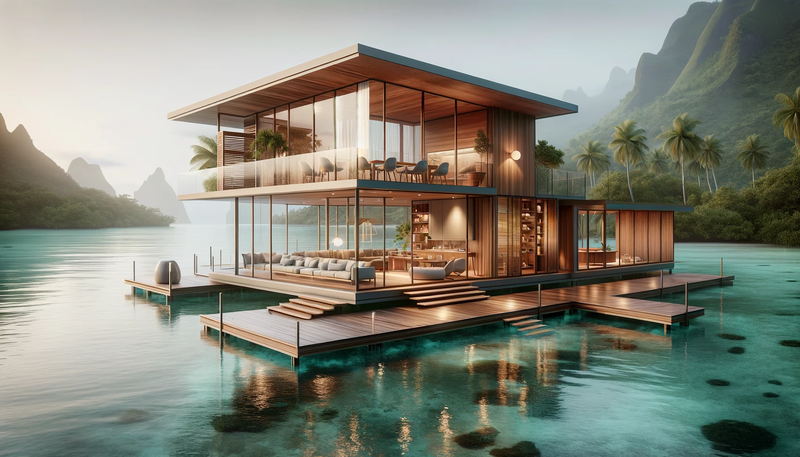
When tasked with creating these unique dwellings, the AI often produced images that leaned more towards the fantastical than the realistic. The renderings frequently resembled scenes from a video game or a cartoon, characterized by exaggerated features and a lack of grounding in real-world physics and materials.
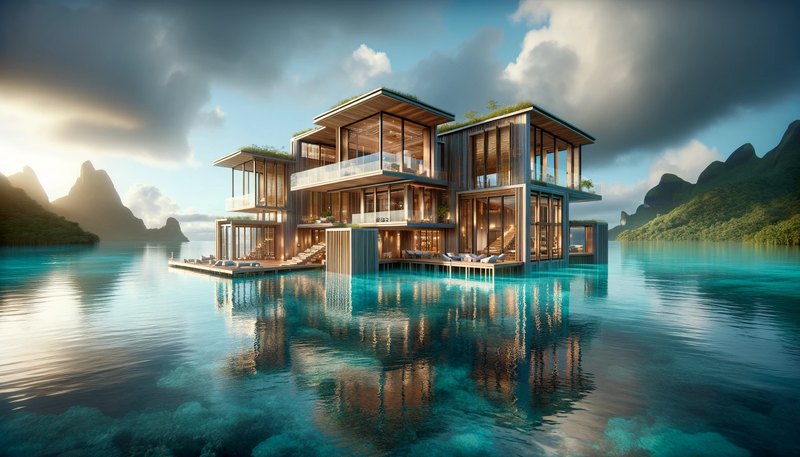
This departure from realism was not just limited to the aesthetic aspect but extended to practical design elements as well. DALL-E struggled to incorporate fundamental architectural principles that ensure the feasibility and safety of floating structures. Essential features like buoyancy systems, anchoring mechanisms, and balance in design were often conspicuously absent or unrealistically portrayed in the images. The challenge lay in guiding the AI to comprehend and apply the intricate balance between imaginative design and engineering realities that floating homes require.
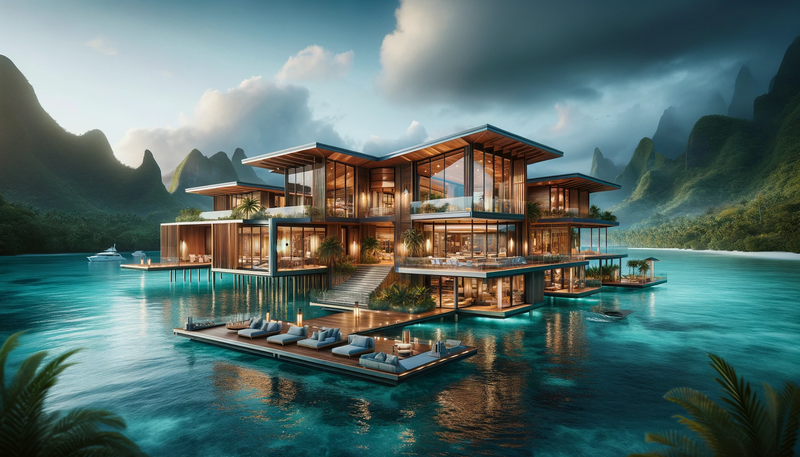
The results underscore a current limitation of DALL-E in areas where architectural creativity must align closely with practical and technical considerations. While the tool can generate visually striking concepts, its ability to adhere to the practicalities of architectural design, especially in unconventional projects like floating houses, remains an area for future development and refinement.
Modular and Transformable Homes
When tasked with illustrating the concept of modular and transformable homes, DALL-E faced significant challenges in accurately representing the dynamic and adaptable nature of such architectures. Modular and transformable homes are defined by their flexibility, often featuring components that can be reconfigured or adapted to different needs or spaces. However, DALL-E's renderings struggled to effectively capture this essence of modularity and transformation.
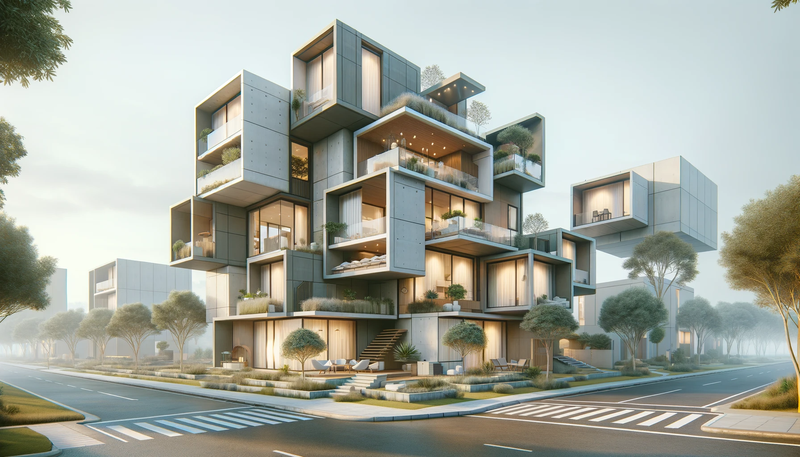
The AI frequently defaulted to using heavy and rigid materials like cement in its visualizations, which contradicts the lightweight and versatile materials typically associated with modular construction. This choice of materials in the renderings deviated not only from the expected aesthetics of modular homes but also from their functional core – the ability to be easily assembled, disassembled, and reconfigured.
Furthermore, DALL-E's difficulty in showcasing the transformative aspect of these homes was evident. The renderings often lacked the depiction of homes in various stages of transformation or failed to illustrate the potential for reconfiguration and adaptability in the design. This shortfall highlights a gap in DALL-E's current understanding of architectural concepts that are dynamic and fluid, as opposed to static structures.
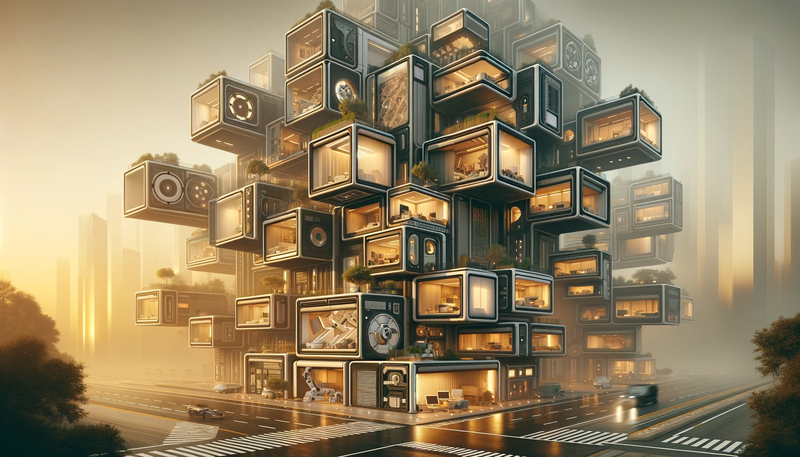
Overall, while DALL-E could generate basic representations of homes, its capability to truly embody modular and transformable architecture's innovative and flexible nature was limited. This limitation points to an area where AI-driven design tools like DALL-E have room for growth, particularly in understanding and visualizing architectural concepts that extend beyond traditional, static structures.
Cliffside Houses
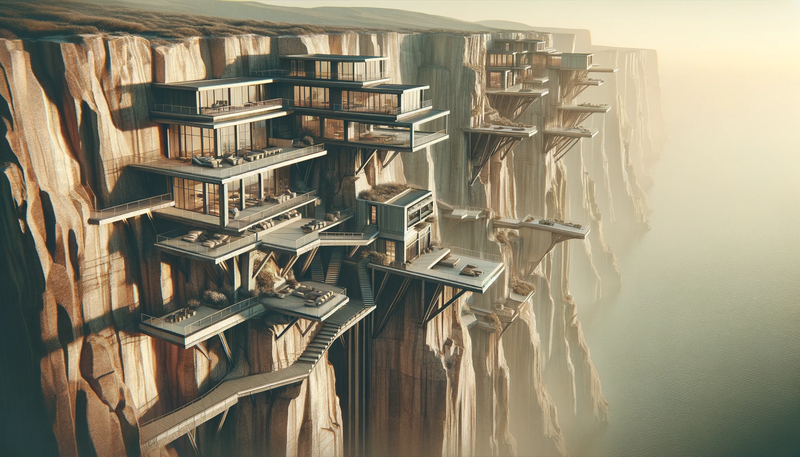
The venture into creating cliffside house designs with DALL-E yielded a mix of intriguing yet impractical results. While the AI demonstrated a flair for creativity, producing visually captivating and unique designs, it struggled significantly in the realm of practicality and real-world applicability.
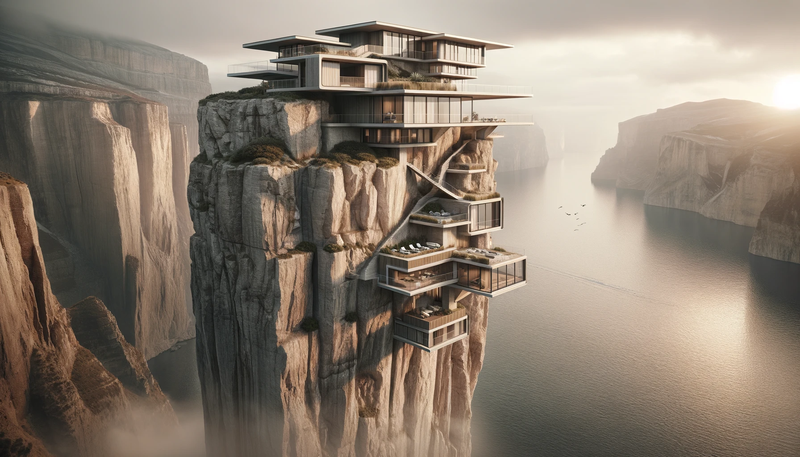
DALL-E's renderings of cliffside houses were often marked by an artistic and almost fantastical approach. These images showcased imaginative structures perched precariously on cliffs, featuring daring architectural elements that, while striking, veered away from realistic engineering and safety considerations. The designs frequently lacked the structural support and stability that real-world cliffside construction demands, such as securing foundations and reinforcements to prevent erosion and withstand weather elements.
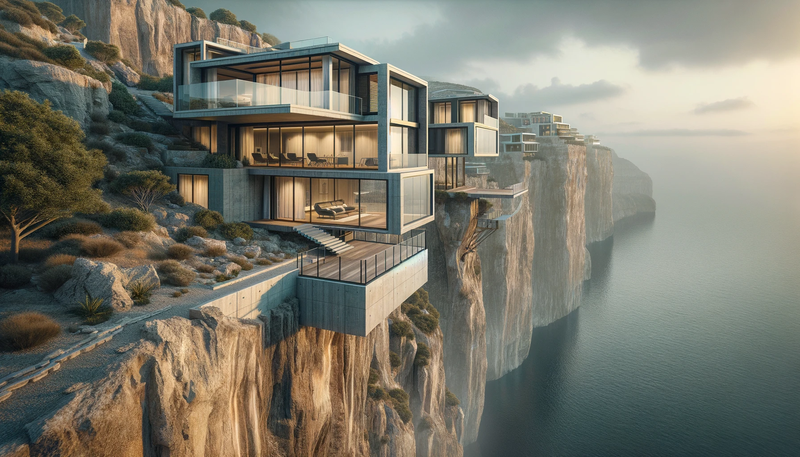
Moreover, the AI seemed to struggle with integrating these homes into their natural surroundings in a feasible and environmentally sensitive way. The lack of realistic interaction between the structures and the cliffside terrain resulted in renderings that appeared more as standalone art pieces rather than viable living spaces.
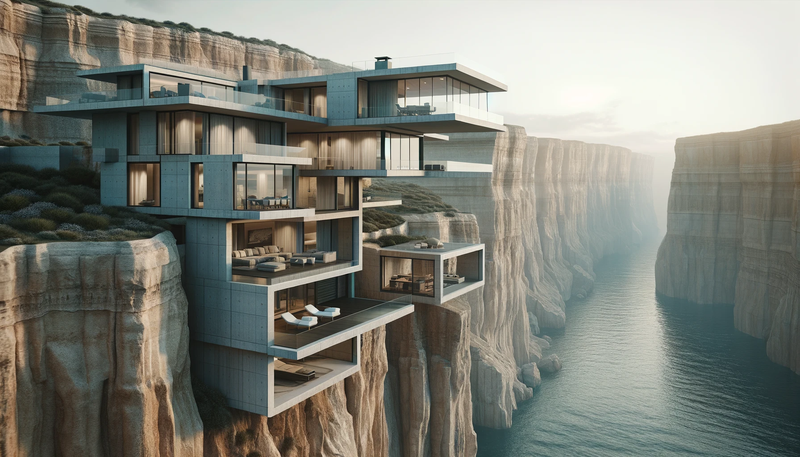
While DALL-E's cliffside house designs were visually engaging and showcased a high degree of artistic freedom, they fell short in depicting homes that could realistically be constructed and inhabited. This underscores a current limitation of DALL-E in generating architectural designs that not only inspire but also adhere to real-world architecture's practical and environmental constraints.
Hobbit-Inspired Earth Houses
The attempt to use DALL-E for creating Hobbit-inspired earth houses highlighted some of the AI's limitations in rendering habitable and realistic architectural designs. These whimsical, earth-integrated homes, popularized by their depiction in fantasy literature and films, pose a unique challenge due to their distinctive and organic architectural features.
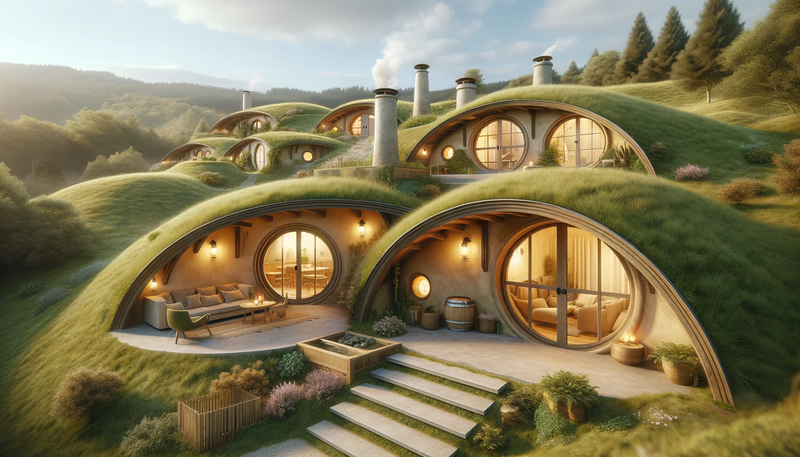
In its effort to generate these earth houses, DALL-E struggled to produce images that conveyed a sense of human habitability. The AI often defaulted to designs that, while reflective of the earthy and rounded aesthetics characteristic of Hobbit homes, missed key elements that make a structure suitable for human living. Essential features like windows, doors, and functional living spaces were either absent or unrealistically portrayed, leading to representations more akin to fantastical sculptures than practical dwellings.
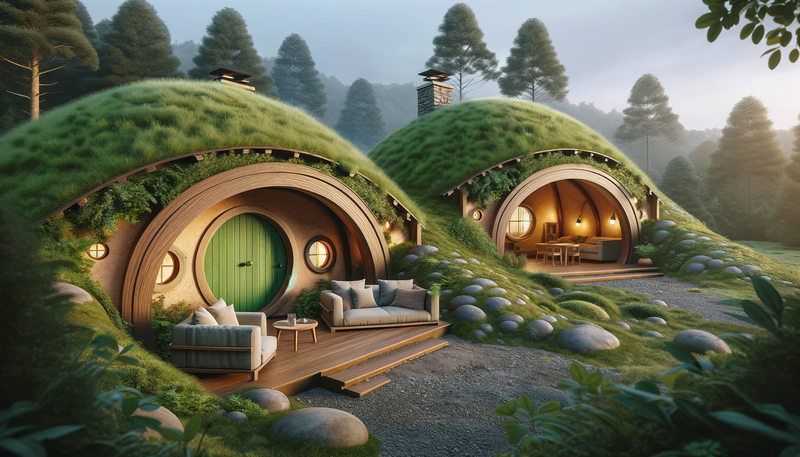
Additionally, the landscaping in DALL-E's renderings frequently took an unusual turn. Instead of the gentle, rolling hills and lush greenery associated with Hobbit homes, the AI generated landscapes featuring large, dinosaur egg-like boulders and other peculiar geological formations. These surreal elements added an extra layer of impracticality and disconnected the designs further from the charming, cozy, and habitable qualities intrinsic to Hobbit-inspired architecture.

Overall, while DALL-E's renderings of Hobbit-inspired earth houses were creative and visually interesting, they largely missed the mark in terms of realism and practicality. The AI's interpretations leaned more towards the abstract and fantastical, lacking the grounded, human-centric design necessary for these types of homes to be considered viable living spaces.
Minimalist Zen Retreats
When tasked with the creation of minimalist Zen retreats, DALL-E's renderings diverged from the quintessential elements that define such spaces. Zen retreats are typically characterized by their simplicity, tranquility, and harmonious integration with nature, focusing on creating a serene and contemplative environment. However, DALL-E's interpretations leaned more towards high-end modern homes, missing the nuanced essence of Zen minimalism.
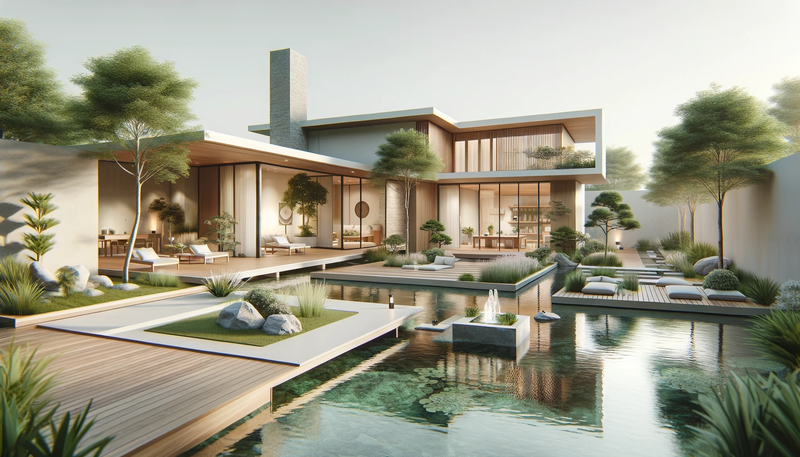
The AI-generated images showcased structures that, while aesthetically pleasing and modern in design, did not capture the Zen retreat's spirit of minimalism and inner peace. These designs often featured sleek, contemporary architecture with sophisticated materials and finishes, which, although visually appealing, strayed from the Zen principle of simplicity and understatement. The emphasis in these renderings was more on luxury and modernity rather than the Zen philosophy of harmony, balance, and connection with the natural world.
Furthermore, the essence of a Zen retreat as a space for meditation and reflection was not effectively conveyed. The settings lacked the elements typically associated with Zen spaces, such as minimalist landscaping, natural materials, and a sense of seclusion and tranquility. Instead, the focus seemed to be on architectural grandeur and modern living, which is contrary to the minimalist and introspective nature of Zen retreats.
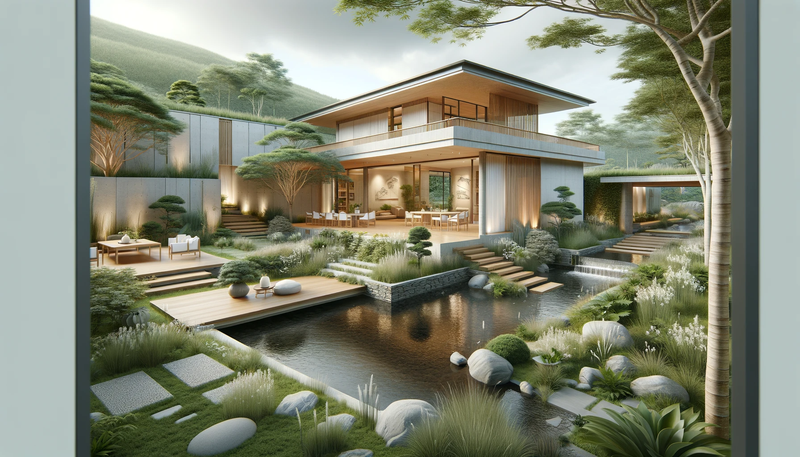
In conclusion, while DALL-E succeeded in creating visually impressive modern homes, it failed to embody the true characteristics of a minimalist Zen retreat. The AI's renderings did not align with the Zen philosophy of simplicity, natural harmony, and serene contemplation, highlighting a gap in its ability to fully grasp and translate the subtleties of specific architectural styles and philosophies into its designs.
Conclusion
In conclusion, our exploration of using DALL-E for conceptual renderings across a diverse range of architectural concepts reveals a fascinating yet complex picture. While DALL-E showcases remarkable capabilities in generating unique and creative designs, its effectiveness varies significantly across different architectural styles and concepts.
DALL-E excels in areas where creativity and imagination take precedence over practicality, such as in biophilic urbanism and some more abstract architectural forms. However, when it comes to designs that require a deep understanding of practicality and functionality, like modular homes, cliffside houses, or minimalist Zen retreats, DALL-E often falls short. It struggles to integrate the critical elements that make these designs both feasible and livable.
Moreover, the AI's interpretations sometimes border on the fantastical, producing images that, while visually striking, are far removed from real-world applicability. This is particularly evident in concepts like Hobbit-inspired earth houses and floating houses, where the renderings veered towards the surreal rather than the practical.
These observations underline the current state of AI in the realm of architectural conceptualization: a powerful tool for initial creative brainstorming and envisioning out-of-the-box concepts, but not yet a reliable stand-alone solution for practical architectural design. The future of AI in this field is undoubtedly bright, but it will require further advancements and perhaps integration with more specialized architectural software and knowledge to bridge the gap between imaginative creation and practical application.
In essence, DALL-E opens doors to unprecedented creative possibilities, enabling us to visualize ideas that might have been difficult or impossible to conceive otherwise. However, it also reminds us of the value of human expertise and insight in transforming these AI-generated concepts into viable, functional, and habitable designs. As AI continues to evolve, its role in conceptual rendering can only expand, potentially revolutionizing the way we approach design and creativity in architecture and beyond.
Our Services
View some of our most popular services below.

